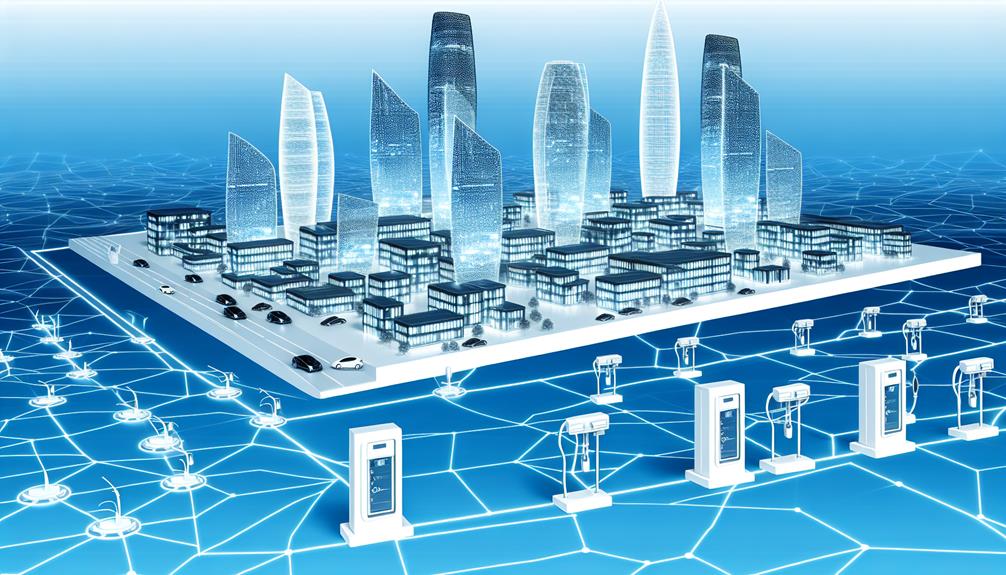The Future of Electrical Services: Predictions and Trends
Did you know that the future of electrical services is set to undergo significant transformations? From renewable energy integration to advancements in smart grid technologies, there are several predictions and trends that are shaping the way we will access and utilize electricity in the coming years.
But what exactly are these trends and how will they impact our lives?
In this discussion, we will explore the exciting possibilities of IoT in electrical services, the integration of automation and artificial intelligence in electrical systems, and the development of electric vehicle charging infrastructure.
Get ready to discover the electrifying future that lies ahead.
Key Takeaways
- Integration of renewable energy and smart grid technologies is crucial for a sustainable and efficient energy system.
- The adoption of IoT and automation in electrical services enables enhanced efficiency and optimization.
- The advancement of AI in electrical systems enhances operational efficiency and reduces the need for human intervention.
- The growth and improvement of electric vehicle charging infrastructure are critical for the widespread adoption of electric vehicles and offer multiple benefits such as reduced greenhouse gas emissions and improved air quality.
Renewable Energy Integration
Renewable energy integration into electrical services is becoming increasingly crucial for ensuring a sustainable and efficient energy system. As the demand for clean and reliable energy continues to grow, it’s essential to incorporate renewable sources such as solar, wind, and hydroelectric power into the electrical grid.
One of the main benefits of renewable energy integration is the reduction of greenhouse gas emissions. By shifting away from fossil fuel-based electricity generation, we can significantly decrease our carbon footprint and mitigate the effects of climate change. Additionally, renewable energy sources are abundant and inexhaustible, providing a long-term solution to our energy needs.
Integration of renewable energy into electrical services also promotes energy independence and resilience. With decentralized power generation, individuals and communities have the opportunity to produce their own electricity and reduce their reliance on centralized power plants. This not only increases freedom but also enhances the reliability and stability of the electrical grid.
However, integrating renewable energy into the electrical grid does come with its challenges. The intermittent nature of renewable sources requires advanced technologies and storage solutions to ensure a consistent supply of electricity. Grid infrastructure must also be upgraded to accommodate the influx of renewable energy sources and facilitate their integration into the existing system.
Advancements in Smart Grid Technologies
Advancements in smart grid technologies have revolutionized the electrical services industry, enhancing efficiency, reliability, and sustainability. Smart grids leverage advanced communication and control systems to optimize the generation, distribution, and consumption of electricity. These technologies enable real-time monitoring and analysis of energy usage, allowing for better management of power flows and load balancing.
One key advancement in smart grid technologies is the implementation of advanced metering infrastructure (AMI). AMI enables two-way communication between the utility and consumers, providing accurate and timely data on energy consumption. This allows for more precise billing, demand response programs, and the ability to identify and resolve issues quickly.
Another important aspect of smart grids is the integration of renewable energy sources. With the increasing adoption of solar and wind power, smart grids facilitate the seamless integration of these intermittent sources into the grid. Through advanced forecasting and control algorithms, smart grids can optimize the use of renewable energy, reducing reliance on fossil fuels and minimizing carbon emissions.
Furthermore, smart grid technologies promote grid resilience and reliability. By detecting and isolating faults, smart grids can minimize downtime and quickly restore power in the event of an outage. Additionally, they enable remote monitoring and control of the grid, reducing the need for physical inspections and improving maintenance efficiency.
Internet of Things (IoT) in Electrical Services
The Internet of Things (IoT) has revolutionized the electrical services industry, connecting devices and systems to enhance efficiency and enable advanced monitoring and control capabilities.
With IoT, electrical services can be remotely monitored and controlled, leading to improved energy management and cost savings. IoT devices, such as smart meters and sensors, can collect and transmit data in real-time, allowing for predictive maintenance and proactive troubleshooting. This technology allows electrical service providers to detect and resolve issues before they become major problems, reducing downtime and increasing reliability.
In addition to monitoring and control, IoT in electrical services enables automation and optimization. By integrating IoT devices with electrical systems, tasks that were once manual can now be automated, improving operational efficiency. For example, IoT-enabled devices can automatically adjust lighting levels based on occupancy or optimize energy usage based on real-time data.
Furthermore, IoT in electrical services opens up opportunities for smarter grids and energy management. By connecting renewable energy sources, such as solar panels, to the grid, IoT can enable better integration and management of distributed energy resources. This can lead to a more sustainable and resilient electrical system.
Automation and Artificial Intelligence in Electrical Systems
Automation and artificial intelligence are revolutionizing the electrical systems industry, enhancing operational efficiency and enabling new levels of optimization and control. With automation, electrical systems can perform tasks autonomously, reducing the need for human intervention and improving productivity. Artificial intelligence algorithms can analyze vast amounts of data, making predictions and optimizing system performance in real-time. These advancements not only streamline operations but also contribute to cost savings and energy conservation.
Automation and artificial intelligence are transforming electrical services in various ways. For example, smart grid technology utilizes automation and AI to monitor and manage power distribution efficiently. By collecting data from sensors and meters, AI algorithms can analyze power usage patterns, predict demand, and optimize the distribution of electricity. This results in reduced energy wastage and improved reliability of the electrical grid.
In addition, automation and AI are being integrated into building management systems. These systems can monitor and control various electrical components such as lighting, HVAC, and security systems. Through AI algorithms, these systems can learn from user behavior and adjust settings accordingly, maximizing energy efficiency and comfort.
Furthermore, automation and AI are revolutionizing the field of electrical maintenance. AI-powered predictive maintenance systems can analyze historical data, identify potential faults, and schedule maintenance activities proactively. By detecting issues before they cause major breakdowns, these systems improve reliability and reduce downtime.
Electric Vehicle Charging Infrastructure
Electric vehicle charging infrastructure is a critical component in the widespread adoption of electric vehicles. As electric vehicles become more popular, the need for an extensive and reliable charging network is paramount. Currently, the infrastructure for electric vehicle charging is developing rapidly, with a wide range of charging options available to suit different needs.
There are three main types of electric vehicle charging infrastructure: Level 1, Level 2, and DC fast charging. Level 1 charging, also known as trickle charging, uses a standard household outlet and provides a slow charging rate of about 2 to 5 miles of range per hour. Level 2 charging, on the other hand, requires a specialized charging station and offers a faster charging rate of about 10 to 30 miles of range per hour. Finally, DC fast charging, or Level 3 charging, provides the fastest charging rate, delivering up to 80% charge in 30 minutes.
To ensure the widespread adoption of electric vehicles, it’s crucial to have a well-distributed and easily accessible charging infrastructure. This means having charging stations in residential areas, workplaces, public parking lots, and along highways. Furthermore, interoperability and standardization of charging equipment and payment systems are essential to ensure a seamless and convenient charging experience for electric vehicle owners.
As the demand for electric vehicles continues to grow, it’s expected that the electric vehicle charging infrastructure will expand and improve, enabling more people to switch to electric vehicles with confidence.







